|
Page < 1 2 3 4 5 6 7 8 9 10 11 12 13 14 15 16 17 18 19 20 21 22 23 24 25 >
Show
in alphabetical order
 441.
Satyanand Stokes aka. Samuel
Evans Stokes (1882-1946), was the son of a wealthy Philadelphian
engineer-businessman of Quaker antecedents, well-known for his
contribution to the elevator technology. Young Samuel was not
interested in following his father into business, and at 22 gave
up his studies at the University
of
Yale, and opted to serve mankind. He set for sail to India
and arrived at the leper home in Sabathu in 1905. He was sent
for relief work to Kangra, then devastated by a severe
earthquake. Thereafter, he came to the Christian Mission House
at Kotgarh. 441.
Satyanand Stokes aka. Samuel
Evans Stokes (1882-1946), was the son of a wealthy Philadelphian
engineer-businessman of Quaker antecedents, well-known for his
contribution to the elevator technology. Young Samuel was not
interested in following his father into business, and at 22 gave
up his studies at the University
of
Yale, and opted to serve mankind. He set for sail to India
and arrived at the leper home in Sabathu in 1905. He was sent
for relief work to Kangra, then devastated by a severe
earthquake. Thereafter, he came to the Christian Mission House
at Kotgarh.
In 1910, he bought a derelict
tea garden, got married and made Barubagh in Kotgarh his home.
But Stokes was of a reflective and enquiring mind and although
he described himself as a "lover of Christ" he could
not shut his mind to Indian metaphysical thought. He learnt Sanskrit, studied eastern and western thought, and expounded his
philosophy of life in a book entitled Satyakam.
In 1932, under
the aegis of Arya Samaj, he became a Hindu, and converted from
Samuel Evans to Satyanand.
There were many Christian
precepts and practices with which Stokes did not agree. In 1932, he converted to
Hinduism, in part because he detested the Christian notion of
eternal punishment.
In
Hinduism he found the validation of his rejection of the
Christian idea of eternal punishment. His belief in universal
salvation, transmigration of the soul and the non-existence of
sin as a power in opposition to holiness show him closer to the Vedantic
philosophy. In the Hindu scriptures he found
"not so much in the actual solutions arrived at, as in the
general tendency of thought and method of approach, the key to
much that the Christian religion, as evolved in the West, has
never attempted to explain, or about which its teachings have
been frankly agnostic."
Though Stokes remained true to
the Christian canon, he showed courage of conviction when he
freely admitted, "The light from the
Hindu scriptures had
come to fill the gaps in Christianity."
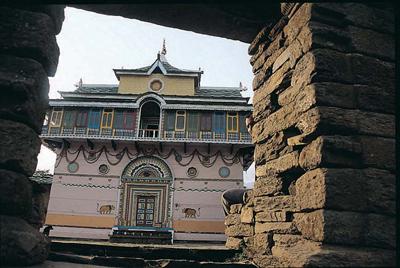
He build the temple that
became his legacy to Thanedar.
Stokes
freely admitted: "The light from the Hindu
scriptures had come to fill the gaps in Christianity."
Likewise, the Christian community expressed shock, anger and
betrayal at Stokes conversion.
***
During his
rest and recuperation days at the Kotgarh church, young Samuel
came in contact with a lot of Sadhus on the Hindustan-Tibet road
making their way to Kailash Mansarovar. While the priest of the
church was finely robed and had three meals a day, the
simplicity of these Sadhus perturbed him and set him thinking
about the Hindu religion.
He builds the temple that
becomes his legacy to Thanedar. Next to the house is an Arya
Samaj Mandir. The temple reclines amidst wooden pillars,
surrounded by inscriptions from the Upanishads and Bhagvad Gita
and gazing at the lofty white
Himalayas
that seemed a stones throw away. Juggal
Kishore Birla, a scion of Indian industry at that time
contributed Rs 25,000 to encourage him. He called the Paramjyoti
Mandir or the Temple
of
Eternal
light, he wanted it to be a storybook in wood and stone.
In
1926, there is evidence in Stokes's writings that he did not
adhere to the Christian doctrine of the divinity of Jesus. It is
evident that he did not tolerate appeals to scripture but
thought all religious scripture could be useful by evoking
spiritual insight. In an essay explaining why he became a Hindu,
Stokes saw no reason for Hindus to convert to Christianity,
denied the uniqueness of Jesus and his message, and confessed
that it would be hypocritical of him to raise his children as
Christians with such reservations.
(source: The
man behind the success story of Kotgarh - By Pamela Kanwar
and A
Quaker who joined freedom struggle - by Randeep Wadehra
and In
a New Book, the Story of An American Who Embraced
India
and
The
India
of My Dreams: Samuel Stokes's Challenge to Christian Mission
442. Dr.
Hilda Raja ( ) was
a professor at Queen Mary's College, Chennai. She has held an
advisory position in the Catholic Bishops Conference in India.
She was a sociology professor at Stella Maris College,
Chennai. .
Her writings are forthright but balanced, precise, incisive,
thought provoking and informative. Apart from being a practicing
Catholic Christian, she is a true nationalist, who values the
cultural heritage of this great country and respects the Hindu
tradition too.
She
is Catholic by religion and an outspoken
critic of religious conversion as it is practiced by
Christian missionaries in India.
Ms.
Raja writes on her blog
that: "There is no place for conversion because this
ancient land of ours was already oriented to its Creator and the
people had connected to the Supreme being of the Cosmos. Much
before Christianity / Islam appeared our forefathers had their
religion. It was their openness and utterly secular outlook
which enabled all world religions to make India their home. To
me India and all that it holds is sacred."
"There is
misconception that Hinduism is not progressive and modern. The
quest for Truth was not restricted to mere meditation but
oriented to the explorations and scientific enquiry into the
universe, thus emerged the tharkashastra. The intellectual basis
of India’s heritage continues.
The quest for truth and the spirit of
free enquiry gave India
an intellectual sharpness. This stands in contrast with the
Abrahamic religions, with their monolithic structures and dogmas
which stifle--nay ban the freedom of enquiry. One leads to the
other--where there is freedom there is greater knowledge and
where there is greater knowledge there is greater prosperity.
Little wonder that
India
attracted people from all over the world. A. L. Basham’s
description of this land in “The wonder that was
India
” unfolds the tapestry with its beautiful colors and
patterns—that was India. The rights of the people and their protection were coded in
the Arthasashtra.
"No country in world can boast of a heritage
where the rights of the people were safeguarded and coded at a
time when slavery existed. Yet the world thinks and even
educated Indians think that civilization came from
outside—that law was brought with the British and that
India
was steeped in ignorance.
"
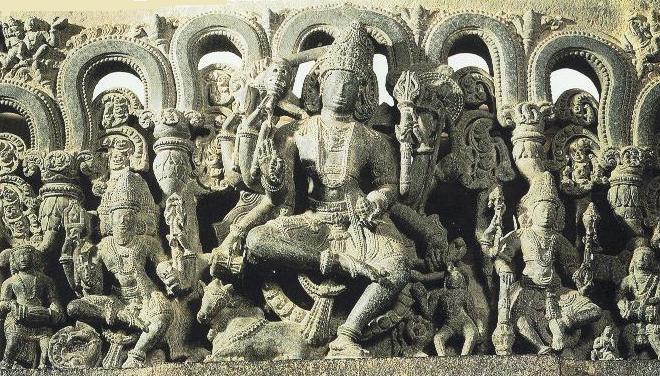
It is
inexplicable how such a rich heritage of Hindu Dharma did not
find a place in our education curriculum. A civilization which
was not only Spiritual but which gave to the world from the
Zero--the decimal system to the sciences like chemistry,
anatomy, medicine, surgical know-how.
Here was a civilization
with spirituality at the core but with sciences of all branches
developing in harmony. This rational spirituality of Sanatana
Dharma gave greater vision of life and an impetus towards a well
balanced growth of the family, society, nation and the world.
(image
source: World Mythology - By Roy Willis
p. 68).
***
It is
almost staggering to find that there was an undying and unending
quest for Truth. This marked with the spirit of free Enquiry
etches the refined contours of
India
’s culture. What is fascinating is how the aim of intellectual
knowledge in
India
expanded in ever widening circle like ripples. The need to
penetrate ignorance and enlighten all the aspects of living
seems to be the pursuit
India
’s ancients were engaged in."
It is
inexplicable how such a rich heritage of Hindu Dharma did not
find a place in our education curriculum. A civilization which
was not only Spiritual but which gave to the world from the
Zero--the decimal system to the sciences like chemistry,
anatomy, medicine, surgical know-how. Here was a civilization
with spirituality at the core but with sciences of all branches
developing in harmony. This rational spirituality of Sanatana
Dharma gave greater vision of life and an impetus towards a well
balanced growth of the family, society, nation and the world.
The majority of the Indians are unaware of this rich mine of
theirs. The Vedic concept of, ‘may all be safe in the world’
speaks volumes of a philosophy that reaches to all and wishes
all safety and peace. In a world with so much of violence and
brutality, when man is against man—nation against nation, this
stands out as bacon beckoning all nations to be knit as a family
in brotherhood.
(source: India's
Gift to the World - A Book review
- By Dr. Hilda Raja). Refer to In
Rome Durga Puja is not welcome - By Hilda Raja
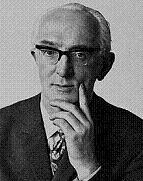 443
Walter
Raymond Drake (1913
- 1989), a British disciple of Charles
Fort (1874 - 1932) published nine
books on the ancient astronaut theme, the first four years
earlier than Erich Von Däniken's bestseller Chariots of the
Gods. In his book Gods
and Spacemen in the Ancient East, he wrote: 443
Walter
Raymond Drake (1913
- 1989), a British disciple of Charles
Fort (1874 - 1932) published nine
books on the ancient astronaut theme, the first four years
earlier than Erich Von Däniken's bestseller Chariots of the
Gods. In his book Gods
and Spacemen in the Ancient East, he wrote:
"The
oldest source of wisdom in the world must surely spring from
India
, whose initiates long ago probed the secrets of heaven, the
story of Earth, the depths of Man’s soul, and propounded those
sublime thoughts which illumined the Magi of Babylon, inspired
the philosophers of
Greece
and worked their subtle influence on the religions of the West."
“Today
we tend to belittle the past and boast our age as the highest
peak in human culture, despite its sadly apparent short-comings;
the common man in the West certainly lives more princely than
many a King centuries ago and enjoys marvels of genius which
would have amazed the old magicians, yet the literature of
Eastern peoples shows that the Ancients sometimes surpassed us
in the very things of which we are proud. The
Indian lyricise of spaceships faster than light and missiles
more violent than H-bombs; their Sanskrit texts
describe aircraft apparently with radar and cameras; the
wonderful ‘Mahabharat’ rivals
the ‘Iliad’, the ‘Odyssey’…”
The
religions and philosophies of the East distilled a sublimity of
thought scarce attained in the West; the wonderful
Indian system of Yoga, the Gnani Yoga of Wisdom, Raja Yoga of
Mind, Hatha Yoga of Body, Bhakti Yoga of Love, Karma Yoga of
Work, developed a discipline millennia ago blending mysticism
with daily life, showing Man’s relation to the Universe
incarnating ever upwards to perfection to Union with God; this
supreme and beneficent teaching now exercising widening
influence in our Western world must surely have sprung from
civilizations long vanished …”
The
sublime Upanishads stress that our whole universe throbs with
One Life.
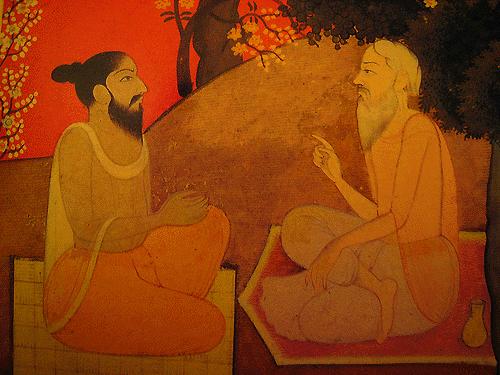
The
sublime Upanishads stress that our whole universe throbs with
One Life.
The
oldest source of wisdom in the world must surely spring from
India, whose initiates long ago probed the secrets of heaven, the
story of Earth, the depths of Man’s soul, and propounded those
sublime thoughts which illumined the Magi of Babylon, inspired
the philosophers of
Greece
and worked their subtle influence on the religions of the West.
(image
source: harekrsna.com).
***
The
oldest literature in the world is probably the Rig Veda, meaning
‘verse-knowledge’, comprising 10,000 invocations to the Gods
written in Sanskrit about 1500 BC,. Sanskrit scholars like the
erudite Dr. Max Muller, agree that the Vedas are far more
ancient than Homer and from the real theogony of the Aryan race,
in comparison the cosmogony and theogony of Hesiod and Genesis
appear crude images of the Vedic sublimity.
The
Ramayana telling in magic imagery the quest of Rama
for his stolen wife Sita, has thrilled the people of India for
thousands of years; generations of wandering story-tellers have
recited its 24,000 verses to marveling audiences captivated by
this brilliant panorama of the fantastic past, the passions of
heroic love, tragedies of dark revenge, aerial battles between
Gods and Demons waged with nuclear bombs; the glory of noble
deeds; the thrilling poetry of life, the philosophy of destiny
and death.
This
wonderful epic of the ‘Ramayana’ the inspiration of the
world’s great classic literature, intrigues us most today by
its frequent allusions to aerial
vehicles and annihilating bombs,
which we consider to be inventions of our own 20th
century impossible in the far past. Students of Sanskrit
literature soon revise their preconceived ideas and find that
the heroes of Ancient India were apparently equipped with
aircraft and missiles more sophisticated than those we boast
today.
The Indian lyricize of spaceships faster than
light and missiles more violent than H-bombs; their Sanskrit texts describe
aircraft apparently with radar and cameras; the wonderful ‘Mahabahrata’
rivals the ‘Ilad’ and the ‘Odyssey’, the ‘Aeneid,’ the plays of
Shakespeare and most of our modern fiction all combined. The
religions and philosophies of the East distilled a sublimity of thought scarce
attained in the West; the wonderful Indian system of Yoga, the Gnani
Yoga of Wisdom, Raja Yoga of Mind, Hatha Yoga of Body, Bhakti Yoga of Love,
Karma Yoga of Work, developed a discipline millennia ago blending mysticism with
daily life, showing Man’s relation to the Universe incarnating ever upwards to
perfection to Union with God; this supreme and beneficent teaching now exerting
widening influence in our Western world must surely have sprung from
civilizations long vanished…”
While
our Western civilization is based on the Greeco-Judaic cultures, it is seldom
realized that the Greeks and the Jews derived many of their fundamental concepts
from old
India
especially after the invasion of Alexander in 327 BC.
Kannada and the Gnani Yogis
speculated on the atom five hundred years before Democritus, Aryabhatta
in the 6th century BC taught the rotation of the Earth, the
scientific principles of medicine, botany and chemistry were established as
early as 1300 BC in
India
while Indian astronomy dates from remote Antiquity.
The
Creation in Genesis seems a primitive version of the profound
teaching of the Days and Nights of Brahman; the tale of Noah an echo of
Vaivasvata warned by Lord Vishnu to build a ship for the coming Flood; the
Jewish Kabbala and various events in the Bible can be traced to Hindu scriptures
written many centuries earlier.
To
minds conditioned by two thousand years of Christianity, the lives and teachings
of
Krishna
and Buddha throw so much doubt on the historicity of Jesus, that we dare to
wonder if the whole Christian Legend is but a plagiarism of Hinduism and
Buddhism. Such apparent blasphemy outrages all our feelings, to doubt
the reality of Jesus seems mortal sin, yet if we honestly study the teachings of
Krishna, Hellenized to Chrestus hence Christ, and compare the fundamental dogma
of Virgin Birth, Miracles, Ritual death on a tree or cross, Immortality, we find
ourselves speculating whether Jesus was a myth based on the earlier historical
Krishna. Many scholars believe that
Old India was the source not only of civilization, the arts and sciences, but
also of all the great religions of Antiquity.
(source: Gods
and Spacemen in the Ancient East - By Walter Raymond Drake p.
25 and 226 and 9 - 49 and
1 – 65
).
Refer to chapter on Vimanas.
 444.
Bharat Gupt ( )
is Associate Professor, Delhi University, Founder member and
Trustee International
Forum for India's Heritage and author of the book India
a cultural decline or revival? 444.
Bharat Gupt ( )
is Associate Professor, Delhi University, Founder member and
Trustee International
Forum for India's Heritage and author of the book India
a cultural decline or revival?
He has observed that:
"Under the
impact of colonial Christianity, Hinduism underwent a special
phenomenon, which may be called as the ‘Commandment-alization
of Hinduism.’ In
India
, this trend still continues even after
Independence
as the Anglophonic ruling class has stayed under the sway of
neo-colonialism. In their hubris, the Abrahamics have not
recognized that the Upanishaic
Brahmavaada came to be evolved
from the same tradition as the Vedic worship of multiple gods and
is the oldest philosophy that propounded the unity of the Divine.
For Christians and Muslims, the problem still exists as a divide
between the people who believe in One omnipotent God and the
people who admit the existence of many gods. The Abrahamic
monotheists claim themselves to be logical and systematized and
allege that polytheists are irrational and incapable of cosmic
vision. It is primarily to address their false claim that one has
to show that Hindus have thought on the subject more deeply.
The
Naasadeeya Sukta of Rig Veda gives
indication that there was somebody who created even before the
gods came into existence.
“Then was not
non-existence nor existence; there was no realm of air, no sky
beyond it. The One, breathless breathed by his own nature; apart
from it was nothing whatsoever.” (Rig
Veda, Book X, verse 129).
No
doubt/It/He/She was the Purusha of the Purusha Sukta. That One,
along with the later well defined Brahman is what the Hindus
believed in. In this sense the unity of the Divine, behind all
gods like Indra, Agni, Varuna, Mitra, Pooshaan, Usha and so many
others of different manifestation is quite evident. ‘Ekam
adviteeyam’ (Chandogya Upanishad,
6-2-1) or ‘Ishaavaasyamidam sarvam’ (Ishopanishad,
1), is the Hindu monotheism that admits also of material looking
manifestations of the Divine. Western
monotheism has come to be riddled with virulent ikonophobia
(hatred for images).
The
Indian philosophies that avoid the pursuit of manifested imagery
have not denounced others as in falsehood and error. While
stating the unity of the Divine, they are not exclusivists as they
do not admit that there can be only some
manifestations/incarnations/characteristics of the One. The
Abrahamic people are the exclusivists and as they insist that God
can have only those characteristics as is found in Allah or
Yahweh. The problem, then, is not One God versus Many Gods but God
as seen by me alone versus God as seen by Others.
The Hindu faith in the
Ultimate Reality behind all beliefs and philosophical systems is
reflected nowhere better than in the benedictory verse of the play
Mahanatakam by the 11th
century poet Hanuman.
“The One who
is worshipped as Shiva by the Shaivas, as Brahma by Vedantees, as
Buddha by Bauddhas, as Kartaa by Naiyayikas the logicians, as
Arhat by the Jains and Karma (yajna) by Meemaansakas; such a
Vishnu, the lord of three worlds, may fulfill your desires.”
Hinduism now
needs to strongly resist this commandment-alization in order to
save its original genius. It also means restoration of the unity
of thought, speech and action which was broken by the
other-worldly religiosity (loka paraangamuckha Bhakti),
Euro-modernity, Protestant, Catholic and Islamic iconoclasm, and
Gandhian dryness/rasaheenataa, but is found as the ambrosiac
kernel in the universe of pagan rituals.”
In
the traditional Hindu cosmology, the Universe was perceived as the
body of the Being or Purusha and the parts of the Universe as his
limbs. The human individual was part of the body and limbs.
Alternatively, the Universe was perceived as a Cosmic Egg (Brahmaanda)
containing the individual. Whatever was contained in the
individual was also perceived to be contained in the Cosmos (yat
pinde e tat brahmaand.e) because the individual was also perceived
as a Purusha, thus asserting a complete unity of the individual
with the Universe. All Hindu ritual was conceived as a method of
heightening the awareness of this unity…"
Replacement of
the Vedic Model of Purusha with the Gutemberg-Newtonian model of
Objectivity. - But a great change of attitude toward the very
value of ritual set in after
Independence
. In the state-manipulated intellectual climate that prevailed
during Nehru’s rule, reality and truth came to be defined in a
realistic Newtonian terms of European physical sciences. This
fascination did not account the post-classical developments in
physics and their implications on philosophy. Not
only were some of the rigorous traditions of native reasoning
disregarded, even the latest views of modern science were
blatantly ignored.
(source: India
a cultural decline or revival?
- By Bharat Gupt p. 4 - 16).
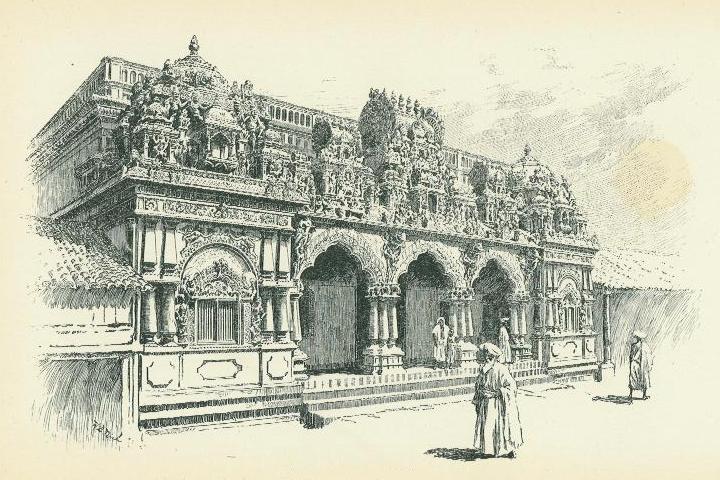
Hindu temple
in Sri Lanka.
Of all the ancients, Hinduism alone
survives in a contemporary form that has recognizable antecedents. Today the
fate of Hinduism still hangs precariously in the balance.
(image
source: Indika - By John F Hurst).
***
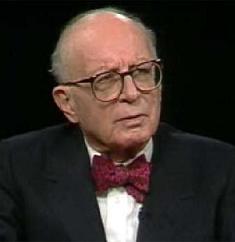 445. Daniel
Joseph Boorstin
(1914 - 2004) was
the grandson of Russian Jewish
immigrants, American
historian, lawyer, professor, Librarian of Congress from 1975 to
1987, prize-winning author of several books including The
Discovers, The Creators and The Seekers
wrote this about
Hinduism: 445. Daniel
Joseph Boorstin
(1914 - 2004) was
the grandson of Russian Jewish
immigrants, American
historian, lawyer, professor, Librarian of Congress from 1975 to
1987, prize-winning author of several books including The
Discovers, The Creators and The Seekers
wrote this about
Hinduism:
“The
Hindus have left an eloquent history of their efforts to answer
the riddle of Creation. The Vedas, sacred hymns in archaic
Sanskrit from about 1500 to 900 BC do not depict a benevolent
Creator, but record a man’s awe before the Creation as singers
of the Vedas chant the radiance of this world. Their objects of
worship were devas (cognate with Latin dues, god) derived from
the old Sanskrit div, meaning brightness. Gods were the shining
ones. The luminosity of their world impressed the Hindus from
the beginning. Not the fitting-together-ness, not the hierarchy
of beings or the order of nature, but the blinding splendor, the
Light of the World. How the world once came into being or how it
might end seemed irrelevant before the brightness of the visible
world.
What
sanctifies the worshipper is no act of conversion, no change of
spirit, but the simple act of seeing, the Hindi word darsan. A
Hindu goes to a temple not to “worship,” but rather for “darshan,”
to see the image of the deity. Each of the cities sacred to each
of the thousands of gods offers its own special darsan: Benares
(Varanasi) for the darsan of Lord Vishvanath, the high
Himalayas
for the darsan of Vishnu, or a nearby hilltop for the darsan of
a local god. In the life of the sacred city of Benares
the quest for seeing embodies much that is distinctive to the
religions of Hindus. The Hindu is dazzled by a vision of the
holy, not merely holy people but places like the Himalayan peaks
where the gods live, or the
Ganges
which flows from Heaven to Earth, or countless inconspicuous
sites where gods and goddesses or unsung heroes showed their
divine mettle. The Hindu pilgrims trek hundreds of miles just
for another darsan.
According
to the Hindus, the deity or a holy spirit or place or image
“gives darsan” amd the people “take darsan” for which
there seems no counterpoint in any
Western religion.
Darsan, is a two-way flow of vision. While the devotee
sees the god, so too the god sees the devotee, and the two make
contact through their eyes. In building a new temple, even
before images of the gods are made, the gods are beseeched to
turn a kindly eye on all who come to see them. And when the
images of the gods are made, their eyes are the last part
completed.
For the Hindu, seeing became a form of touching. Western
religious traditions were wary of the seen, of the image, and
the Protestant Reformation built a theology on this suspicion of
all images.
Western
religions begin with a notion that One – One God, One Book,
One Son, One Church, One Nation under God – is better than
many. The Hindu, dazzled by the
wondrous variety of the creation, could see not see it that way.
For so multiplex a world, the more gods the better. Howe could
any one god account for so varied a creation? And why not
another alternative between monotheism and polytheism? It is
hardly surprising that the awestruck Hindu never came up with a
single grand Creator-god.
Western
religion begin with a notion that One – One God, One Book, One
Son, One Church, One Nation under God – is better than many.
An Olympian democracy
allowed the Hindu devotees to focus his darsan on one particular
god at each moment.
In
India, the tolerant, ever growing community of gods and goddesses,
each divinity was willing to take a turn receiving the darsan of
the faithful. None of the nasty envy
of the Greek gods whose festering pride and jealousy motivated the
Homeric epics! And how unlike the sovereign Creator-God of the
Hebrews and Christians and Muslims. “for
I the Lord thy God am a jealous
God.” But
Vishnu, Shiva, and Devi is each momentarily seen as creator,
sustainer, and supreme power, each surrounded by a galaxy of
lesser gods. The Western worshiper is baffled in his quest for a
hierarchy among them. The dazzled vision sees no hierarchy but the
mystery expressed in every growing thing. As the Upanishads,
commentaries on the Vedas, sang:
“Fetch
me a fruit of the banyan tree.”
“Here is one, sir.”
“Break it.”
“I have broken it, sir.”
‘What do you see?”
“very tiny seeds, sir.”
“Break one.”
“I have broken it, sir.”
“Now what do you see?”
“Nothing, sir.”
“My son,” the father said, “ what you do no perceive is the
essence, and in that essence the mighty banyan tree exists.
Believe me, my son, in that essence is the self of all that is. That
is the Truth, that is the Self. And you are that Self, Svetaketu!”
It
is hardly surprising that the awestruck Hindus never came up with
a single grand Creator God.
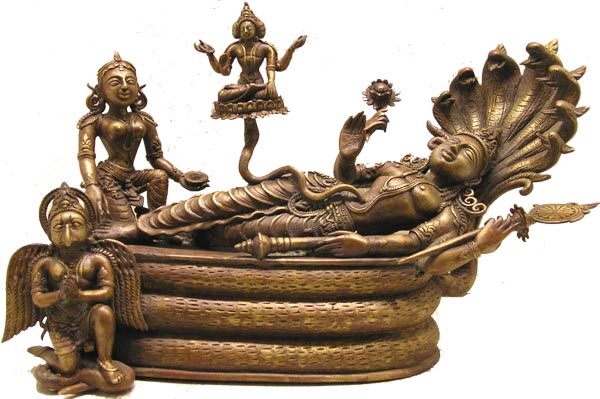
Hinduism
- An Olympian democracy.
In
India, the tolerant, ever growing community of gods and
goddesses, each divinity was willing to take a turn receiving
the darsan of the faithful. None of the nasty envy of the Greek
gods whose festering pride and jealousy motivated the Homeric
epics! And how unlike the sovereign Creator-God of the Hebrews
and Christians and Muslims. “for I the Lord thy God am a
jealous God.”
The
Hindus never allowed
themselves the comfort of dogma. How many were the gods? Who
ruled among them? Despite all this wondrous wealth of myth and
poetry, the Brahman poet in the Rig
Veda sang courageous doubt.
Western
religious traditions (Judeo-Christianity and Islam) were wary of the seen, of the image, and
the Protestant Reformation built a theology on this suspicion of
all images.
***
While
the Hindus sought and found the solace of myth in their
countless communities of god and goddesses, they never allowed
themselves the comfort of dogma. How many were the gods? Who
ruled among them? Despite all this wondrous wealth of myth and
poetry, the Brahman poet in the Rig
Veda sang courageous doubt. So went their “Hymn
of Creation:
But,
after all, who knows, and who can say?
whence it all came, and how creation happened?
The gods themselves are later than creation,
so who knows truly whence it has arisen?
Whence
all creation had its origin
he, whether he fashioned it or whether he did not,
he, who surveys it all from highest heaven,
he knows – or maybe even he does not know.
And
there is no deeper division between West and East than that
marked by this reluctance of Hindu sages to answer the
luminosity of the creation with simple dogmas and definitions.
For
the Hindus the creation was not a bringing into being of the
wonder of the world. Rather it was a dismemberment, a
disintegration of the original Oneness. For him the Creation
seemed not the expression of a rational, benevolent Maker in
wondrous new forms but a fragmenting of the unity of nature into
countless limited forms. The Hindu saw the creation of our world
as “the self-limitation of the transcendent.” For the Hindu
our very notion of creation was reversed. Instead of
transforming nothing into everything, the Hindu creation broke
into countless imperfect fragments what was already there. The
Hindu reached back for the Oneness that was there in the
beginning and he aimed to reintegrate nature. The cycles of
birth and death have perpetuated that disintegrating force of
creation. Samsara, the transmigration of the soul from one life
to another, perpetuated the separateness of the individual. The
object for all was to “get off the wheel,” to escape the
cycle, and merge finally into the original One.
While the aim of the Christian faithful would be
“eternal Life,” the aim of the Hindu was to be uncreated. Yoga,
or “union,” was the disciplined effort to reverse creation
and return to the perfect Oneness from which the world had been
fragmented.
(source:
The Creators: A History of Heroes of
the Imagination - By Daniel J Boorstin p. 4 - 8).
He
has also observed:
"The
Hindu dynasties produced their many ornate versions of the
primeval mountain – dome, spire, hexagonal or octagonal tower.
The surfaces and panels, the niches and friezes of these stone
monuments, bubble with images of plants, and elephants, and of
men and women in all postures. The
grandest of them, the Hindu temple Kailasa (Shiva’s
paradise) at Ellora, in south-central
India
, ingeniously used the mountain itself
to make the effigy of a divine mountain. A
mountain-carved-out-of-mountain, Kailasa was constructed by
first cutting a trench into the mountain to isolate a mass of
rock 276 feet long, 154 feet wide, and 100 feet high. By working
from the top of the mass down, the rock cutters avoided the need
for scaffolding. The product of two hundred years’ labor was a
worthy replica of Shiva’s paradise, Mount
Kailasa
in the
Himalayas. Hindu architects and sculptors down to their latest efforts,
as at Khajraho in central
India
(c.1000), never gave up their rebuilding of
Mt. Meru, and spent their energy with ever greater profligacy in carving
erotic images of the reunion of man and his gods. The sikhara,
or spires, which topped the Hindu temple also meant mountain
peak. Perhaps the most gigantic religious
monument in the world is the temple complex of Angkor
Wat, built by King
Suryavarman II as his sepulcher and
the temple of his divinity. The temple here, fantastically
elaborated and multiplied, is a vast filigreed steeped pyramid,
a sculptured mountain.
"
(source:
The
Discoverers - By Daniel Joseph Boornstin p. 85 –
86).
446.
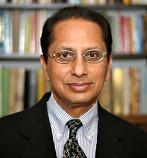 Deepak
Shimkhada ( ) was
in the faculty of Claremont McKenna College in Claremont,
California where he taught courses on Asian religions including
Hinduism, Buddhism and the Visions of the Divine Feminine. He is
currently a visiting professor at California State University in
Northridge. Deepak
Shimkhada ( ) was
in the faculty of Claremont McKenna College in Claremont,
California where he taught courses on Asian religions including
Hinduism, Buddhism and the Visions of the Divine Feminine. He is
currently a visiting professor at California State University in
Northridge.
He gives the composition and
meaning of Om thus:
The sound of
OM is followed by a silence, and the silence is
reconnected with the sound, hence completing a full
circle. Om is composed of three letters, and yet it's not a
word. The unique aspect of Om is that it is monosyllabic. It is
considered to be the sound of creation, hence it's primordial.
He is the author of the book, The
Constant and Changing Faces of the Goddess: Goddess Traditions
of Asia. He has written:
"The temple of Kumari, a living
embodiment of the Hindu goddess Durga, has been a significant
shrine of national importance in Nepal for over three centuries.
Ever since Nepal was thrown open to the world with the abolition
of the Rana dynasty in the mid twentieth century, the temple has
also increasingly become a popular tourist attraction. While the
temple itself is only three centuries old, the tradition of
worshipping the goddess in a virgin form in South Asia and among
the Hindus is over two millennia old. Not only was the ancient
shrine to her at Kanyakumari (the virgin maiden) at the southern
tip of the Indian subcontinent well known to the Romans, but the
worship of a virgin girl is an essential part of the autumnal
worship of the goddess Durga. Nowhere is this religious festival
more important than in Bengal among the Bengali speaking Hindus
where a virgin girl is the center of the celebration. The
Maoists of Nepal should note that the Communists who have been
ruling West Bengal for over two decades have not abolished the
tradition."
(source: A
Tribute to Hinduism: Thoughts and Wisdom spanning continents and
time about India and her culture - By Sushama Londhe
p. 57 and The
Future of Nepal’s “Living” Goddess: Is Her Death
Necessary? - By Deepak Shimkhada).
447. Gene D Matlock
( ) is author of several books including India
Once Ruled the Americas and Jesus
and Moses Are Buried in India, Birthplace of Abraham and the
Hebrews. In his book, Yishvara
2000  he
has remarked that : he
has remarked that :
"In
ancient times, the country we of today call India was not
confined to the Indian subcontinent alone. Its northern limit
was the Artic Circle or North Polar regions. Its human inhabited
parts began in the northeastern extreme of Siberia, including
Alaska, extending downward through what are now Russia, Turkey,
Iran, Afghanistan, Pakistan, Kashmir, and every other nation in
those regions not named down to and including Antarctica or the
uninhabited South Polar regions. The Indians in the North Polar
regions down to Iran were called Scythians. These Scythians also
extended as far west as the British Isles and eastward into
China. They gave their name to Scotland. The Indians south of
today's Iran were and still are, called Bharatiya.
As
far as we know, everyone originally spoke Sanskrit
dialect, also such North Indian languages as Brahma
Bhasha or Balhika Bhasha. We are told that Sumerian was the
world's first civilized nation. The "Outer Space"
cultists like to say that astronauts from other planets founded
the Sumerian civilization because it seemed to "spring up
all at once." According to them, this proves that someone
from outside this planet flew in suddenly, landed, and left
civilized people behind. They're going to be disappointed to
find out that a highly developed
civilization existed in India at least two millenniums before
the Sumerian civilization, from 8,000 to 6,000 BC, in
what is now Afghanistan, Pakistan, Tibet and Kashmir. According
to Hindu tradition, a privilege few in that society even owned
flying machines....""The citizen of that region of
Northern India were known as Yadvas, Yadu, Yahu-Deva, Yauda,
Yahuda etc.
In his book, India
Once Ruled the Americas! he states: "The
people of India have long known that their ancestors once sailed
to and settled in the Americas. They called America 'Patala,'
The Underworld,' not because they believed it to be underground,
but because the other side of the globe appeared to be straight
down."
(source:
Yishvara
2000 - By Gene D Matlock p. 1 - 3 and India
Once Ruled the Americas!).
 448. Jerry
Earl
Johnston
(
) two-time
winner of the national Wilbur Award. He is a columnist, critic, and feature writer for the Deseret
News. He has won awards from the Associated Press, Reader's
Digest, Society of Professional Journalists, and the Utah
Arts Council.
He is also the author of Dads
and Other Heroes.
He has observed that: 448. Jerry
Earl
Johnston
(
) two-time
winner of the national Wilbur Award. He is a columnist, critic, and feature writer for the Deseret
News. He has won awards from the Associated Press, Reader's
Digest, Society of Professional Journalists, and the Utah
Arts Council.
He is also the author of Dads
and Other Heroes.
He has observed that:
"Of
the five major world religions -- Jewish, Christian, Buddhist,
Islam and Hindu -- Hinduism is likely
the least understood by Westerners. People see
aspects of it -- the bathing in the Ganges
River, Yogis in meditation, the Hare Krishnas -- but they seem like
so many random puzzle pieces.
That's
because Hinduism exists as a series of unlinked pieces.
There is no doctrine to
follow in Hinduism. No central authority. To be a Hindu you only
have to declare yourself one. And unlike the other four major
religions, Hinduism has no founder, no beginning, which leads
many Hindus to claim the religion has existed as long as the
universe. Scholars have so far traced
the religion back at least 3,500 years, to the
Indus
Valley
in what is now
Pakistan
. There, an ancient civilization
blossomed and became surprisingly sophisticated....."
The striking together of those two cultures produced our
earliest traces of modern Hinduism, though scientists have few
answers for how it all came to be.
Do Hindus
worship animals? Well, yes and no. They
worship animals as manifestations of the great Absolute, or
Brahman -- an eternal reality behind the multiplicity of forms.
When told worshipping animals is idolatry, they may
reply, "Why do you limit the forms
the Absolute
can assume?"
One
of the best-known "puzzle pieces of Hinduism" is reincarnation,
the idea that the essence of each individual keeps recycling
itself until it is released.
But reincarnation is really about cleansing -- like that
bath in the
Ganges
River
. Imagine a pair of dirty gym socks. You run them through one wash cycle in
the washing machine, but that doesn't do the trick. So you run
them through again to make them cleaner. Maybe even a third
time. After enough washings, they are ready to come out.
Living in the world forces us to suffer. As we work our way through our
challenges and burdens we search for ways out. Each time we are
reincarnated we have moved along the path.
There are Hindu holy books -- such as the Vedas
-- to help people discover how to free themselves.
In the end, Hinduism is a fascinating religion -- a religion that,
despite newspaper stories like this, lies beyond explanation.
(source: Hinduism
for beginners
- By
Jerry Johnston - deseretnews.com
10/18/2009).
 449.
Charles Michael Byrd aka
Charukrishna (1952 ) who describes himself as
being “of black, white and Cherokee heritage,” made a name
as the editor and publisher of Interracial Voice Web site from
1995 to 2003. 449.
Charles Michael Byrd aka
Charukrishna (1952 ) who describes himself as
being “of black, white and Cherokee heritage,” made a name
as the editor and publisher of Interracial Voice Web site from
1995 to 2003.
In his first book,
The
Bhagavad-Gita in Black and White: From Mulatto Pride to Krishna
Consciousness,
Byrd, whose Krishna name is Charukrishna, has said he found the answer to his lifelong quest of
transcending race, ethnicity, religion and other physical
categories to ascend to a higher, universal identity. This book
is primarily aimed at the multiracial population in America, and
any American who wants to avail him or herself of the Vedic
knowledge and how it might apply to the current situation of
race consciousness in the United States.
"The Bhagavad Gita is an important source book on yoga, is the
essence of India's Vedic wisdom, and is one of the great
spiritual and philosophical classics of the world. Remarkably,
however, the setting for this best known classic of spiritual
literature is an ancient Indian battlefield - in the land of
Kurukshetra." "At the last moment before entering
battle, the great warrior Arjuna begins to wonder about the real
meaning of his life. Why should he fight against his friends and
relatives? Why does he exist? Where is he going after death? In
the Bhagavad Gita, the 'Supreme Personality of Godhead, Lord
Kirshna - Arjuna's friend and spiritual master - brings His
disciple from perplexity to spiritual enlightenment through
instruction in the science of self-realization. In the course of
doing so, Krishna concisely but definitively explains
transcendental knowledge - karma-yoga (the path of God
realization through dedicating the fruits of one's work to God),
jnana-yoga (the path of spiritual realization through a
speculative philosophical search for truth), and bhakti-yoga
(linking with the Supreme Lord through devotional service).
"The
perennial philosophy of the Gita has intrigued the philosophical
mind of man, both Eastern and Western, for millennia. Henry
David Thoreau wrote that in relation to the Bhagavad
gita, "our modern world and its literature seem puny and
trivial."
"Most
of us are familiar with the late George
Harrison's 1970's hit "My Sweet Lord" in
which he sings of longing to be with and to see Lord Krishna.
"Hare Krishna" is a mantra that one chants. The holy
name of the Lord is His sound incarnation, and since the Lord is
the absolute whole, there is no difference between His holy name
and His transcendental form. Thus by chanting the holy name of
Lord Krishna one can directly associate with Him by sound
vibration. We are all expansions of God's spiritual energy, and
we are all trying to find a way out of the trap of maya or the
illusory material energy. We're all trying to find out our way
back home - back to Godhead."
(source:
The
Bhagavad-Gita in Black and White: From Mulatto Pride to Krishna
Consciousness - By Charles Michael Byrd
p. 1 - 9).
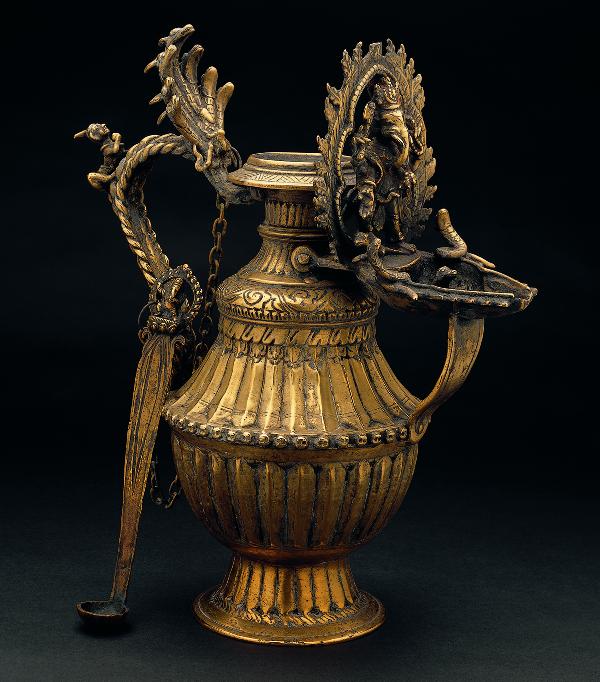
Sukunda, oil
lamp with water pot, copper, circa 18th century, from
Nepal. Sukunda which actually conflates a water pot with a lamp
embodies the principle of life and death through water and fire
the same way Lord Vishnu and Lord Shiva symbolize
respectively.
photo
courtesy: Dr. Deepak Shimkhada.
(image source: A
Tribute to Hinduism: Thoughts and Wisdom spanning continents and
time about India and her culture - By Sushama Londhe
p. xxii).
***
450.
Alok
K Bohara is Professor
of Economics at the University
of
New Mexico
and he has remarked that:
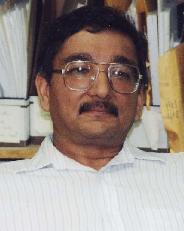 "Half
a century later, it was a nuclear physicist J. Robert
Oppenheimer who finally brought the Gita into the
popular vocabulary of the scientists in the West by citing this
quote from the Bhagavad Gita.
"If
the radiance of a thousand suns were to burst at once into the
sky, that would be like the splendor of the mighty one. "
and "Now I am become Death, the destroyer of worlds."
(July 16, 1945, inscription at first nuclear test site Trinity, New Mexico)." "Half
a century later, it was a nuclear physicist J. Robert
Oppenheimer who finally brought the Gita into the
popular vocabulary of the scientists in the West by citing this
quote from the Bhagavad Gita.
"If
the radiance of a thousand suns were to burst at once into the
sky, that would be like the splendor of the mighty one. "
and "Now I am become Death, the destroyer of worlds."
(July 16, 1945, inscription at first nuclear test site Trinity, New Mexico)."
"With
this began a western love affair with the wonderful tradition of
the Vedic philosophy and the Gita. Since then, many scientists
have quoted the Gita. For example, famous astro-physicist Carl
Sagan was awed by the revelation in the Gita that the creation
and destruction, an essential part of the cosmic evolution, was
actually postulated in a more realistic vast time scale
[8.17-8.19]."
“The
Hindu religion is the only one of the world’s great faith
dedicated to the idea that the cosmos itself undergoes an
immense, indeed an infinite number of deaths and rebirths. It is
the only religion in which the time scales correspond to those
of modern scientific cosmology. Its cycles run from our ordinary
day and night to a day and night of Brahma, 8.64 billion years
long, longer than the age of the Earth or the sun and about half
the time since the Big Bang.”
"Meditation,
yoga, and the idea of spiritual living have now become an accepted
part of the mainstream society. These popular phenomena have
also begun to come under objective scrutiny. As the science
discovers the power of spirituality through various scientific
tests, the essence of the Gita becomes ever more relevant to our
modern society. The simple idea of meditation discovered five to
six thousand years ago in the Rigveda (oldest of the four
Vedas), and a preferred choice of the true knowledge seekers,
has been scientifically shown to have power to alter brain
waves. Experiments have also shown that meditation reduces
criminal intent, stress, and anger, and helps with recovery from
illness."
"To
that end, quantum physics has attempted to show through
experiment that the
sub-atomic particles behave unpredictably (in a probabilistic
sense) and can exist in multiplicity except when it is observed.
This raises the possibility that the physical surrounding around
us is just one of many possible “worlds” that comes in
existence in its fixed form only in reference to our viewing or
the frame of mind. In Gita,
Krishna
alludes to the possibility of this other “parallel world” by
telling Arjuna of having already witnessed the Mahabharata
battle and its outcomes. Is this the maya (illusion) that
the Gita warns us about? That is, is reality the projection of
our mind as postulated in the Gita?"
(source: Science
and the Gita
- By Alok K Bohara).
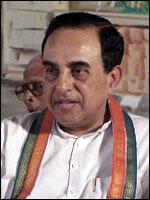 451.
Dr. Subramanium Swamy (1939 - ) He is also a reputed economist and
worked as Assistant Economic Affairs Officer, United Nations Secretariat, New
York in 1963. He worked with two Nobel laureates, Simon Kuznets and Paul A.
Samuelson for his doctorate in economics at the Harvard
University, awarded in 1965. He was a faculty at Harvard in 1964 and has
been teaching there off and on for 12 years with the latest stint completed in
2005. He is acknowledged as an authority on comparative studies of India and
China. He is also well-versed in the Mandarin Chinese (Hanyu) language. He was
Professor of Economics at the Indian
Institute of Technology, Delhi from 1969. 451.
Dr. Subramanium Swamy (1939 - ) He is also a reputed economist and
worked as Assistant Economic Affairs Officer, United Nations Secretariat, New
York in 1963. He worked with two Nobel laureates, Simon Kuznets and Paul A.
Samuelson for his doctorate in economics at the Harvard
University, awarded in 1965. He was a faculty at Harvard in 1964 and has
been teaching there off and on for 12 years with the latest stint completed in
2005. He is acknowledged as an authority on comparative studies of India and
China. He is also well-versed in the Mandarin Chinese (Hanyu) language. He was
Professor of Economics at the Indian
Institute of Technology, Delhi from 1969.
He is the
President of the Janata Party and author of the book Hindus
Under Siege - The Way Out and
Hindutva and National Renaissance
He has written eloquently about
Hinduism and danger Hindus face today. Hinduism is under an
invisible multi-dimensional siege, and that the manifestation of
this siege can be seen by those alerted to it. There are four
dimensions - 1. Religious - denigration of Hindu icons. 2.
Psychological - in the foisting of fraudulent version of our
history. 3. Physical - the Islamic terrorist driven ethnic
cleansing of Hindus of Kashmir and Bangladesh, and the
money-induced conversion of Hindus to Christianity. 4. Cultural
- through globalization of tastes, dress and interpersonal
morality that are determined in the Anglo-saxon white Christian
world ("The West").
"Hinduism,
known as Santana Dharma is unique in that in all the world, it
has a continuous and unbroken tradition for the longest time;
and it is a religion constituted by its theology, cultural
ethos, and civilizational history. India's Hindu society is
founded on the content of these three constituents. Hindustan,
as India is known abroad even today (eg. Yindu guo in Chinese,
Hind in Arabia), as concept is defined as a nation of Hindus and
those others in the nation who accept that their ancestors are
Hindus and revere their legacy. The Hindu ethos provided a
sanctuary and home to those of other faiths fleeing from their
countries due to religious persecution. That is the glorious
Hindu tradition, the ethos of compassion and co-option that is
unparalleled in world history."
"
The true factual history is that defiant Hindus suffered
persecution and economic depravation during Islamic and
Christian reigns, such as through taxation - jizia and plain
brutality, but Hindus by and large refused to capitulate and
convert. These legacies need to form the mindset of the modern
Hindu. What exactly is today confronting Hindus, is however,
much more difficult to meet than earlier in history because the
forces at work to erode and undermine HIndu faith, unlike
before, are unseen, clandestine, pernicious, deceptive but most
of all sophisticated and media savvy. Tragically therefore, a
much more educated and large numbers of Hindus have been
unwittingly co-opted today in this sinister conspiracy directed
by foreigners who have no love for India and who also see (much
as Lord Macaulay saw in the 19th century), that the hoary Hindu
foundation of India is a stumbling block for the furtherance of
their nefarious perfidious game. Adherence to Hinduism is also
being sought to be diluted in the name of modernity and this
dilution is made a norm of secularism. The
concept of a collective Hindu mindset is being ridiculed as
chauvinist and retrograde, even fundamentalist. What Swami
Vivekananda, Bankim Chatterjee, Sri Aurobindo, and Subramaniya
Bharati had achieved by raising Hindu consciousness to that end,
has now been depleted and dissipated over the last six
decades."
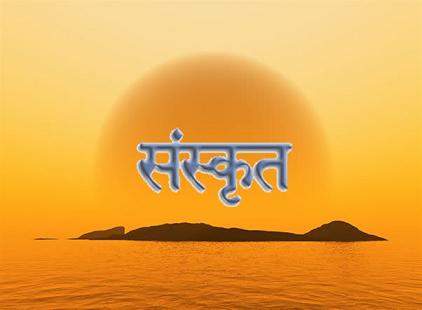
In India's long history,
Sanskrit
has been the greatest integrating force, the source of cultural
continuum, the medium of literary creativity, the voice of the
sages and the languages of the most sublime thoughts and the
profoundest of the philosophies of life.
The
great
grammarian Panini is now being called the first
software man, without the hardware. And the focus is on the
roughly 4,000 rules of Sanskrit grammar that he evolved. Rules
that are so scientific and logical in manner that they closely
resemble structures used by computer scientists throughout the
world."
(image
source: mutinywordpress.com).
***
Writing
about Sanskrit - he says: " In India's long history, Sanskrit
has been the greatest integrating force, the source of cultural
continuum, the medium of literary creativity, the voice of the
sages and the languages of the most sublime thoughts and the
profoundest of the philosophies of life. Sanskrit had its impact
in many countries outside. It became the language of the learned
even in the South-East Asia and to some extent parts of Central
Asia. Most interestingly, many of the ancient Sanskrit plays
that exists were found not in India but in Turfan on the edge of
the Great Gobi desert in China. The great
grammarian Panini is now being called the first
software man, without the hardware. And the focus is on the
roughly 4,000 rules of Sanskrit grammar that he evolved. Rules
that are so scientific and logical in manner that they closely
resemble structures used by computer scientists throughout the
world."
(source:
Hindus Under Siege: The Way Out - By Dr.
Subramanium Swamy
p. 1 - 111). Refer to More
Equal Than Others: Study of the Indian Left – by
Ravi
Shanker Kapoor
 452.
Professor
Dean Brown ( ) an eminent Theoretical
Physicist, cosmologist, philosopher and Sanskrit scholar, whose
translation of the Upanishads was published by the Philosophical
Research Society. 452.
Professor
Dean Brown ( ) an eminent Theoretical
Physicist, cosmologist, philosopher and Sanskrit scholar, whose
translation of the Upanishads was published by the Philosophical
Research Society.
In
an interview with Jeffrey
Mishlove of Thinking
Allowed TV show brings
about an interesting
co-relation of Sanskrit & Physics.
He has pointed out that most European languages can be traced back to a
root language that is also related to Sanskrit
– the sacred language of the ancient Vedic religions of
India
. Many English words actually have Sanskrit origins.
Similarly, many Vedic religious concepts can also be found in
Western culture.
He discusses the fundamental idea of the Upanishads
– that the essence of each
individual, the atman, is identical to the whole universe, the
principle of Brahman. In this sense, the polytheistic traditions
of
India
can be said to be monistic at their very core.
(source:
Interview with Jeffrey Mishlove -
Thinking Allowed).
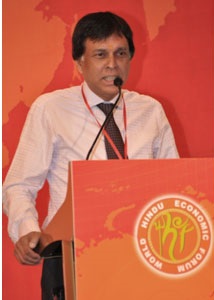 453.
Dr.
Gautam Sen was a lecturer in politics of the world
economy, London School of Economics and Political Science, and a
member of the Indo-British Roundtable. He is the author of the
book, The
Mind of Swami Vivekananda and
director of Gandhi-Einstein
Foundation. 453.
Dr.
Gautam Sen was a lecturer in politics of the world
economy, London School of Economics and Political Science, and a
member of the Indo-British Roundtable. He is the author of the
book, The
Mind of Swami Vivekananda and
director of Gandhi-Einstein
Foundation.
He has
written about the danger a tolerant Hinduism faces today:
"The most significant
aspect of Hinduism is not just shared popular custom and
culture, but a philosophical and practical orientation towards
life."
"Hindus often repeat the
forlorn cry that the truth will triumph. In some abstract sense
such a conviction may be valid because trial and error propel
supposedly rational humankind towards verisimilitude. But such
an outcome does not preclude that much will vanish in the
interim while rational man achieves higher levels of
consciousness and approaches the truth. Satyameva
Jayate did not prevent
countless Jews being incinerated in gas chambers and everything
known as Hinduism may also perish. The Jewish tragedy in Europe
was colossal and the demise of Hinduism may only turn out to be
more long drawn out, but inevitable. The path to truth is
littered with the corpses of the innocent as untruth overcomes
itself. The
deeply rooted self-doubt and self-destructive impulse of
Hinduism has joined hands with the opportunistic Semitic paws
that had been stroking their kill since time immemorial. The
nominally Hindu
intellectual class is
in virtual unison in their wish to crucify their past, embracing
Christian and Islamic imperialism instead.
Of all the ancients, Hinduism alone
survives in a contemporary form that has recognizable antecedents.
Perhaps this is primarily the case
because economic transformation and modernity have been slow in
enveloping Hindu society. By contrast, Japan, despite escaping
modern colonial depredation succumbed to the forces of
modernity, though not without a struggle to retain its older
identity. In its indecorous haste towards modern statehood China
seems impatient to discard anything of
the past that might stand in the way of a militarised
and garish nationalist incarnation. And it has dragged Tibet
down with it in paroxysms of ignorant malice. Its economically
successful Korean neighbour has been turned into a mere
Christian outpost by aggressive proselytisation.
The
fate of Hinduism still hangs precariously in the balance.
An important dimension of the
academic curriculum should be based firmly on the heroic
struggles of Hindu and Sikh kingdoms to defend their way of life
and sovereignty and reflection on the manifold ideas and
practices of indigenous traditions. Every student must emerge
knowledgeable about the divinity of Lord Ram, the Buddha, Guru
Nanak and Ramakrishna, the transcendent significance of the Adi
Shankara and the achievements of the many saints that succeeded
him."
(source: Practice
is what matters: Hindu, only a Hindu - By Dr. Gautam Sen and
Manifesto
for saving Hindu India - By Gautam Sen).
Refer to How
India's Intellectuals spread lies - By Ravi Shanker Kapoor and
More
Equal Than Others: Study of the Indian Left – by
Ravi
Shanker Kapoor.
 454.
Erich von Daniken (1935
- ) known as the father
of the ancient astronaut theory and Swiss author of many books including Chariots of the Gods has
extensively written about the flying apparatus, the Vimanas in
the epics of India thus: 454.
Erich von Daniken (1935
- ) known as the father
of the ancient astronaut theory and Swiss author of many books including Chariots of the Gods has
extensively written about the flying apparatus, the Vimanas in
the epics of India thus:
The 'Ramayana'
telling in magic imagery the quest of Rama for his stolen wife,
Sita, has thrilled the people of India, for thousands of years;
generations of wandering story-tellers have recited its 24,000
verses to marveling audiences captivated by this brilliant
panorama of the fantastic past, the passions of heroic love,
tragedies of dark revenge, aerial battles between Gods and
demons waged with nuclear bombs; the glory of noble deeds; the
thrilling poetry of life, the philosophy of destiny and
death.
This wonderful epic of the
'Ramayana,' the inspiration of the world's great classic
literature, intrigues us most today by its frequent allusions to
aerial vehicles and annihilating bombs, which we consider to be
inventions of own twentieth century impossible in the far past.
Students of Sanskrit literature soon revise their preconceived
ideas and find that the heroes of Ancient India were apparently
equipped with aircraft and missiles more sophisticated than
those we boast today. The thirty-first chapter of the Samasranganasutradhara, ascribed to King Bhojadira in the 11th
century, contains descriptions of remarkable flying ships such
as the elephant-machine, wooden-bird-machine traveling in the
sky, wooden-vimana-machine flying in the air,
door-keeper-machine, soldier-machine, etc. denoting different
types of craft for different purposes.
" In the Indian national
epic the Mahabharata, dating
from the pre-Christian past, one of the 80,000 couplets gives
philosophical expression to the immensity of time.
'God embraces space and time.
Time is the seed of the universe.'
The most fascinating tales of
war in the air waged with fantastic weapons transcending our own
scientific-fiction today are narrated in the 'Mahabharata', a
wonderful poem of 200,000 lines, eight times as long as the
'Iliad' and 'Odyssey' combined, a veritable world in literature.
Transmuting the martial adventures and
exquisite passions brood the sublime teachings of the Bhagavad
Gita with their incalculable
influence on the Greek philosophers and the great Thinkers of
the West. We today are more intrigued by the aerial
craft and wonder weapons suggesting some secret science inspired
by Beings from Space.
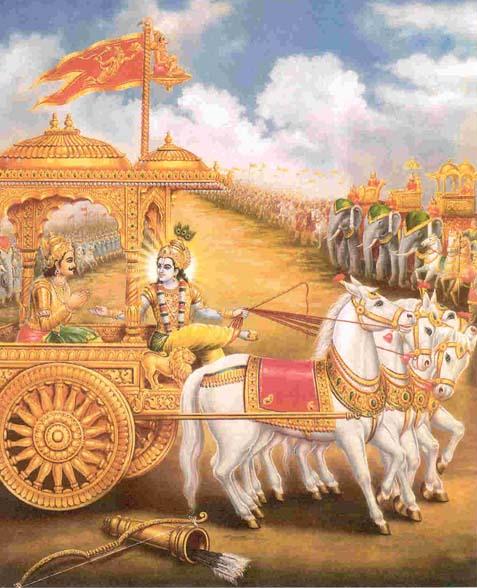
The discourse between the hero,
Arjuna, and the Lord Krishna, as the warrior hesitates to fight
his own kinsfolk form the lofty
Bhagavad Gita, The Song of the Lord, wherein Krishna,
reveals the meaning of the universe, the wisdom of Brahman, and
the duty of men, expounding the religion of the Hindus.
***
The discourse between the hero,
Arjuna, and the Lord Krishna, as the warrior hesitates to fight
his own kinsfolk form the lofty
Bhagavad Gita, The Song of the Lord, wherein Krishna,
reveals the meaning of the universe, the wisdom of Brahman, and
the duty of men, expounding the religion of the Hindus.
"Heroes soared to the
skies in celestial cars and fought aerial duels blasting their
rivals with explosive darts or annihilated armies with nuclear
bombs. These enchanting stories of old India, more fascinating
than our own science fiction, told of a warm colorful land of
culture, its society sparkling with bejeweled splendor, where
princes and poets, saints and scoundrels, mystics and magicians,
lived with an exhilaration unequalled until the glittering
Renaissance awoke the genius of Italy to life; in those exotic
kingdoms beyond the Himalayas the Spacemen felt at home in a
sophistication they could never find amid the stark austerity of
the Peloponnese or the proud intolerance of Palestine.
The Sanskrit
tales glow with a humanism and humor distilled in bewitching
poetry, depicting a genial, cultured society ages old, surely
inspired by some wondrous, resplendent civilization from the
stars."
(source: According
to the Evidence - By Erich von Daniken p. 161 and
Chariots of the Gods
- By Erich von Daniken
p. 1 - 50).
Refer to chapter on Vimanas
 455. Steven J Rosen aka Satyaraja
Dasa (1955 - ) Was
initiated disciple of A. C. Bhaktivedanta Swami Prabhupada. He
is the founding editor of The Journal of Vaishnava Studies.
He is also an associate editor of Back to Godhead, the
magazine of the Hare Krishna Movement. 455. Steven J Rosen aka Satyaraja
Dasa (1955 - ) Was
initiated disciple of A. C. Bhaktivedanta Swami Prabhupada. He
is the founding editor of The Journal of Vaishnava Studies.
He is also an associate editor of Back to Godhead, the
magazine of the Hare Krishna Movement.
He has said in his book, The Hidden
Glory of India:
"Spirituality informs all aspects of Indian culture. It permeates
family and social life, as well as, many major political
movements. To the average person living in India, religion is an
expression of universal truth, a profound complex outgrowth of
the soul. Indian religions is so all-encompassing that it
engages practitioners differently from the Western religious
traditions.
"India's
timeless spiritual teachings have an allure that has beckoned
millions: from seekers trekking high in the snowy Himalayas to
austere mendicants meditating on the serene banks of the
Ganges. "
(source:
The
Hidden Glory of India - By Steven J Rosen
p 1 - 8).
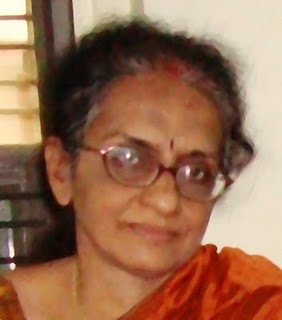 456.
Radha
Rajan is editor of vigilonline. She has passionately
observed about the danger that Hinduism faces today: 456.
Radha
Rajan is editor of vigilonline. She has passionately
observed about the danger that Hinduism faces today:
"The Hindu
civilization is unique in that it defies being classified as
ancient
India, medieval
India
and modern or contemporary India. While this classification is true of countries and nations
that have a pre-Christian and/or pre-Islamic history and even
true of Christian nations where Christianity itself over time
has undergone radical changes in its core contents resulting in
a sharp disconnect between say medieval England and contemporary
England, the core features of Indian/Hindu civilisational
character has endured and remained the same. Hinduism poses the
biggest challenge to the predatory Abrahamic faiths for just two
reasons:
Hinduism alone has demonstrated how Hindus, while possessing a
strong sense of ‘us’, have dealt with ‘them’ without
annihilating ‘them’, without destroying ‘their’ way of
life or belief systems, and without violating ‘their’
societies. And that is why Hindus never conquered territory to
destroy ‘them’, never waged aasuric wars as part of their
core belief or as a matter of faith, never undertook murderous,
homogenizing missions. Historically, before post-independent
Indian public discourse re-defined ‘Hindu tolerance’ and
ahimsa, Hindus and Hindu society have also demonstrated that
independent of state support or state power, they are capable of
defending their dharma, their core beliefs and their territory
from predatory religions which threatened their way of life and
worldview. And this, for Islam, Christianity, Marxism and their
state supporters and terrorist methods, is the bigger challenge.
Outside of
territories governed by Sanatana Dharma the world has not known
spontaneous or harmonious diversity where diversity is accepted
as the way of Creation and existence. Christian and Islamic
countries have been homogenous by the very nature of their
religion. Homogenising societies and nations is a violent
political intent realized by religion and vise versa and even
after two thousand years of bloody history and pervasive
destruction of other cultures and nations it doesn’t look like
either Islam or Christianity will give up their homogenizing
mission as the fundamental purpose for existence.
"
(source: vigilonline.com).
 457.
Theos Casimir Bernard (1908
- 1947) was
an accomplished American practitioner of Yoga and a scholar of
religion and explorer. Bernard
pioneered Indian and Tibetan studies at
Columbia
University. He published several accounts of the theory and
practice of the religions of
India
and Tibet, including his PhD dissertation on Hatha Yoga. 457.
Theos Casimir Bernard (1908
- 1947) was
an accomplished American practitioner of Yoga and a scholar of
religion and explorer. Bernard
pioneered Indian and Tibetan studies at
Columbia
University. He published several accounts of the theory and
practice of the religions of
India
and Tibet, including his PhD dissertation on Hatha Yoga.
In his
book Hindu Philosophy he
writes that:
"There is an innate in the human heart a metaphysical hunger to
know and understand what lies beyond the mysterious and illusive
veil of nature. This is true from savage to savant. Each in his
own way, according to his own capacity, tries to fathom the
eternal mystery of life. From the beginning of time, teachers
have endeavored to bridge the gap between the seen and the
unseen and to show cause for the inescapable experiences of
sorrow and suffering that engulf mankind. In the West, man's
perceptual knowledge of the external world has been his
measuring rod, his basis for theorizing.
"Since
the dawn of Western civilization, there have been few
achievements in the realm of philosophy that have been able to
outlive the scientific findings of a single century. With the
advent of every new discovery, we have to revise our scheme of
things. The entire sea of science is strewn with theories that
have had to be abandoned because the inventive genius of man has
been able to bring to light new facts that would not fit into
the previous theories. The latest ideas are always called
improvements and "evolution."
"The
West refuses to accept the postulate that the world of mind and
matter is but an appearance of a deeper reality which lies
beyond the perception of our senses, regardless of how magnified
these may be by powerful instruments of precision. One
of the reasons for this is due to the preconceived notion that
man cannot know metaphysical truths by direct experience;
therefore, at best, metaphysical truths can only be
speculations, inferences, or ungrounded faith. Even if it were
possible, the West maintains that no man has ever attained such
supreme knowledge. Another attitude is
that all systems of thought must be mutually contradictive, and
that, if one of them be true, the rest must be false. There is
little place left for various interpretations of a single
philosophy to suit different minds."

"The
West refuses to accept the postulate that the world of mind and
matter is but an appearance of a deeper reality which lies
beyond the perception of our senses, regardless of how magnified
these may be by powerful instruments of precision.
Another attitude is
that all systems of thought must be mutually contradictive, and
that, if one of them be true, the rest must be false. There is
little place left for various interpretations of a single
philosophy to suit different minds."
(image source: Hindu Philosophy - By
Theos Casimir Bernard).
***
"In
the Orient, it has been accepted that man can know metaphysical
truths by direct experience. He need not depend upon
speculation, inference, or faith. The literature is replete with
the writings of men who are said to know the whole truth of
Nature and human existence, and the teachings of these men have
been set forth in the philosophical systems of ancient
India.
"Hindu
philosophy does not attempt to train one to discern metaphysical
truths; it offers a way of thinking which enables us one
rationally to understand the reality experienced by self
fulfilled personalities, and thereby to lead one to the
realization of Truth. In this light, philosophy is seen as art
of life and not a theory about the universe, for it is the means
of attaining the highest aspirations of man. It is not for the
discovery, but for the understanding of Truth."
(source:
Hindu Philosophy - By Theos Casimir Bernard
p. 1 - 5).
 458. George
(Augustine) Thundiparambil
columnist has written some articles including 'Why
this war on Hinduism?, The
Source of Bias against Hindus and The
Vedas and the Original Sin.
He has observed in his
article, Sanatana
Dharma: Beacon of Human Consciousness: 458. George
(Augustine) Thundiparambil
columnist has written some articles including 'Why
this war on Hinduism?, The
Source of Bias against Hindus and The
Vedas and the Original Sin.
He has observed in his
article, Sanatana
Dharma: Beacon of Human Consciousness:
"The
awareness of dharma as the underlying principle of all nature is
the basic characteristic of a Hindu. Every other principle is
considered subordinate to this. There are many definitions of
this word and various translations that include
“righteousness,” “justice,” “duty,”
“religion,” etc., but any or all of these indicate parts of
it and consist of something more. Dharma transcends belief. For
a Hindu, it is an inner certitude. It arises from the certainty
that upholding dharma is not only the right way, but the only
natural way to think and act. Dharma is ethical and adharma,
which is the absence of dharma, is unethical and is termed
‘paapa’ (sin). One upholds dharma by rightful conduct; by
doing the right thing at the right time at the right place.
Dharma is directly related to one’s consciousness. One can
sense dharma in every situation and in every stage and station
of our life. It manifests as one’s awareness of a
transcendental ideal that prompts us to make decisions and act
in a certain way."
"Whatever
connotations the word ‘dharma’ evoke as applied in a
context, it is the idea of ‘Sanatana Dharma’ which knits all
Hindus together, whether they be in Nepal, India, or in the
Caribbean. Every Hindu knows what dharma is. Every Hindu also
knows that dharma is sanatana (without beginning or end,
perennial) as it transcends phenomena. It is more than a belief
or a maxim which has had a phenomenal birth and which therefore
would also have a phenomenal death. Dharma is bound to the human
soul (atman) just as heat is bound to fire, or fluidity to water
[2]. Dharma is bound to an object as its inseparable function.
When one speaks of ‘Sanatana Dharma,’ one is speaking of an
eternal bond that is indivisible from human beings; you cannot
separate heat from fire. For an individual, the supreme dharma
(the supreme function) is the realization of the supreme truth."
"Sanatana
Dharma (Hinduism)
is the link that
connects the present to the pre-historic past. It is the oldest
religion on earth, and it still exists as vibrant as ever,
because it subsists from holding on to goodness.
It is demonstrated very clearly in Mahabharata that the
upholding of dharma is possible only by humans, not by gods. It
falls on Yudhishtira (also called Dharmaputra - ‘son of
dharma’) to save dharma from perishing. Dharma comprises the
continuum of human consciousness. And the whole of humanity owes
to the Hindus for redeeming dharma or positive goodness from the
onslaught of evil, which is nothing but positive ignorance that
has consumed all other ancient religions in its wake. The
ancient slogan: ‘dharmo rakshati rakshite’ (dharma saves the
one who saves dharma) speaks for itself."
The
greatest expositor of dharma, Sage
Vyasa, speaks at the end of Mahabharata:
“Dharma
is that by which everything endures. It is the substratum of
everything. It is untranslatable in any language. Through desire
for wealth or out of greed or fear, do not give up dharma, aye,
even to save your own life. Dharma is eternal happiness.”
(source: Sanatana
Dharma: Beacon of Human Consciousness - By
George (Augustine) Thundiparambil).
459. Damodar P Singhal
(1925 - 1986) Indian historian, was a lecturer in the
Asian History in the University of Malaya before moving over to
the University of Queensland. He wrote in his book, India and
World Civilization:
"Indian civilization is
notable for its antiquity and continuity. Apart from its
vitality, the continuity of Indian civilization is largely due
to its ability to adapt to alien virtues, to harmonize
contradictions and assimilate new ideas. No country was more
frequently invaded and occupied by foreigners, yet, in ancient
times, no civilization spread abroad more extensively than that
of India. And thus, occupying a central position in the cultures
of the world, India has contributed enormously to human
civilization. Whilst other ancient civilizations have long
ceased to exist, Indian civilization has continued to grow
despite revolutionary changes."
"The oldest philosophical
tradition in the world is to be traced in the ancient Vedas.
Although the religious and philosophical spirit of India emerges
distinctly in the Rig Veda, the
Upanishads are its most brilliant exposition, for the
Vedic civilization was naturalistic and utilitarian, although it
did not exclude cosmological and religious speculation. One of
the most significant concepts of Vedic India was that of rta,
the idea of the true order of the world, a concept that may be
considered the forerunner of dharma of ancient and even modern
times. Older than Plato or Confucius, the Upanishads are the
most ancient of philosophical works and contain the mature
wisdom of India's intellectual and spiritual attainment. They
have inspired not only the orthodox systems of Indian thought
but also the so-called heterodox schools such as Buddhism.
In profundity of thought and beauty of style, they have rarely
been surpassed not only in Indian thought but in the Western and
Chinese philosophical traditions as well. The
Upanishads have greatly influenced Indian culture throughout
history and have also found enthusiastic admirers abroad.
Schopenhauer was almost lyrical about them and so was Max
Muller. The Upanishads are saturated with the spirit of inquiry,
intellectual analysis, and a passion for seeking the truth.
"
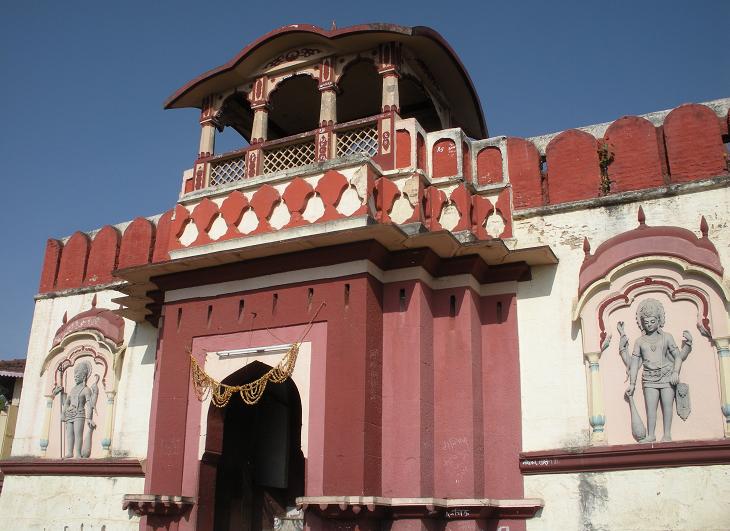
Parvati
palace and temple, Pune, India.
(image
source: webmaster's
own collection of photos).
Indian
philosophical thought, in contrast to the Western tradition, has
remained more stable and more clearly continuous. In spite of
its metaphysical nature and religious overtones, Indian
philosophy is essentially practical, aiming at realizing
spirituality what is known intellectually. Knowledge without
vision is meaningless. Hence, Indians call their philosophy
darshan, vision.
***
"Indian
philosophical thought, in contrast to the Western tradition, has
remained more stable and more clearly continuous. In spite of
its metaphysical nature and religious overtones, Indian
philosophy is essentially practical, aiming at realizing
spirituality what is known intellectually. Knowledge without
vision is meaningless. Hence, Indians call their philosophy
darshan, vision. " "Philosophy, as religion, is seen
India as a means to an end, not as an end in itself. Hence,
there is no room for dogma or intolerance in Indian tradition
because the roads to truth are more than one. The infinite
reality cannot be comprehended by the finite mind."
Thus, perhaps, India is the
home of philosophy. Certainly India is a country where
philosophy has always been very popular and influential. An
American scholar (Will Durant) has stated that teachers of
philosophy in India were as numerous as merchants in Babylonia.
The sages have always been heroes of the Indians, and some of
their festive celebrations were marked relentless debates
between chief exponents of rival schools of thought. The prayer
of the oldest Upanishad - From the unreal to the real, From
darkness to the Light, From Death to Immortality - is frequently
reflected in Plato's Dialogues."
(source: India
and World Civilization - By Damodar P Singhal
p. 1 - 33).
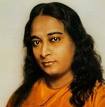 460. Paramhansa
Yogananda (1893
– 1952) was an
Indian yogi and guru who introduced many westerners to the
teachings of meditation and Kriya Yoga through his book, Autobiography
of a Yogi. 460. Paramhansa
Yogananda (1893
– 1952) was an
Indian yogi and guru who introduced many westerners to the
teachings of meditation and Kriya Yoga through his book, Autobiography
of a Yogi.
Yogananda
taught his students the need for direct experience of truth, as
opposed to blind belief. He said that “The true basis of
religion is not belief, but intuitive experience. Intuition is
the soul’s power of knowing God. To know what religion is
really all about, one must know God.”
Echoing
traditional Hindu teachings, he taught that the entire universe
is God's cosmic motion picture, and that individuals are merely
actors in the divine play who change roles through
reincarnation. He taught that mankind's deep suffering is rooted
in identifying too closely with one's current role, rather than
with the movie's director, or God.
He taught
Kriya Yoga and other meditation practices to help people achieve
that understanding, which he called Self-realization. Self-realization
is the knowing in all parts of body, mind, and soul that you are
now in possession of the kingdom of God; that you do not have to
pray that it come to you; that God’s omnipresence is your
omnipresence; and that all that you need to do is improve your
knowing.
He has written: "The
Vedas declare that the ignorant man who rests content with
making the slightest distinction between the individual soul and
the Supreme Self is exposed to danger," Shankara the great
monist has written. "Where there is duality by virtue of
ignorance, one sees all things as distinct from the Self. When
everything is seen as the Self, then there is not even an atom
other than the Self. . . .
The
atomic structure of matter was well-known to the ancient Hindus.
One of the six systems of Indian philosophy is Vaisesika, from the
Sanskrit root visesas, "atomic individuality." One of
the foremost Vaisesika expounders was Aulukya, also called Kanada,
"the atom-eater," born about 2800 years ago.
In an article in East-West,
April, 1934, a summary of Vaisesika scientific
knowledge was given as follows: "Though the modern 'atomic
theory' is generally considered a new advance of science, it was
brilliantly expounded long ago by Kanada, 'the atom-eater.' The
Sanskrit anus can be properly translated as 'atom' in the latter's
literal Greek sense of 'uncut' or indivisible. Other scientific
expositions of Vaisesika treatises of the B.C. era include (1) the
movement of needles toward magnets, (2) the circulation of water
in plants, (3) akash or ether, inert and structureless, as a basis
for transmitting subtle forces, (4) the solar fire as the cause of
all other forms of heat, (5) heat as the cause of molecular
change, (6) the law of gravitation as caused by the quality that
inheres in earth-atoms to give them their attractive power or
downward pull, (7) the kinetic nature of all energy; causation as
always rooted in an expenditure of energy or a redistribution of
motion, (8) universal dissolution through the disintegration of
atoms, (9) the radiation of heat and light rays, infinitely small
particles, darting forth in all directions with inconceivable
speed (the modern 'cosmic rays' theory), (10) the relativity of
time and space.
(source: wikipedia.org
and Autobiography
of a Yogi - By Paramhansa
Yogananda).



Page < 1 2 3 4 5 6 7 8 9 10 11 12 13 14 15 16 17 18 19 20 21 22 23 24 >
|